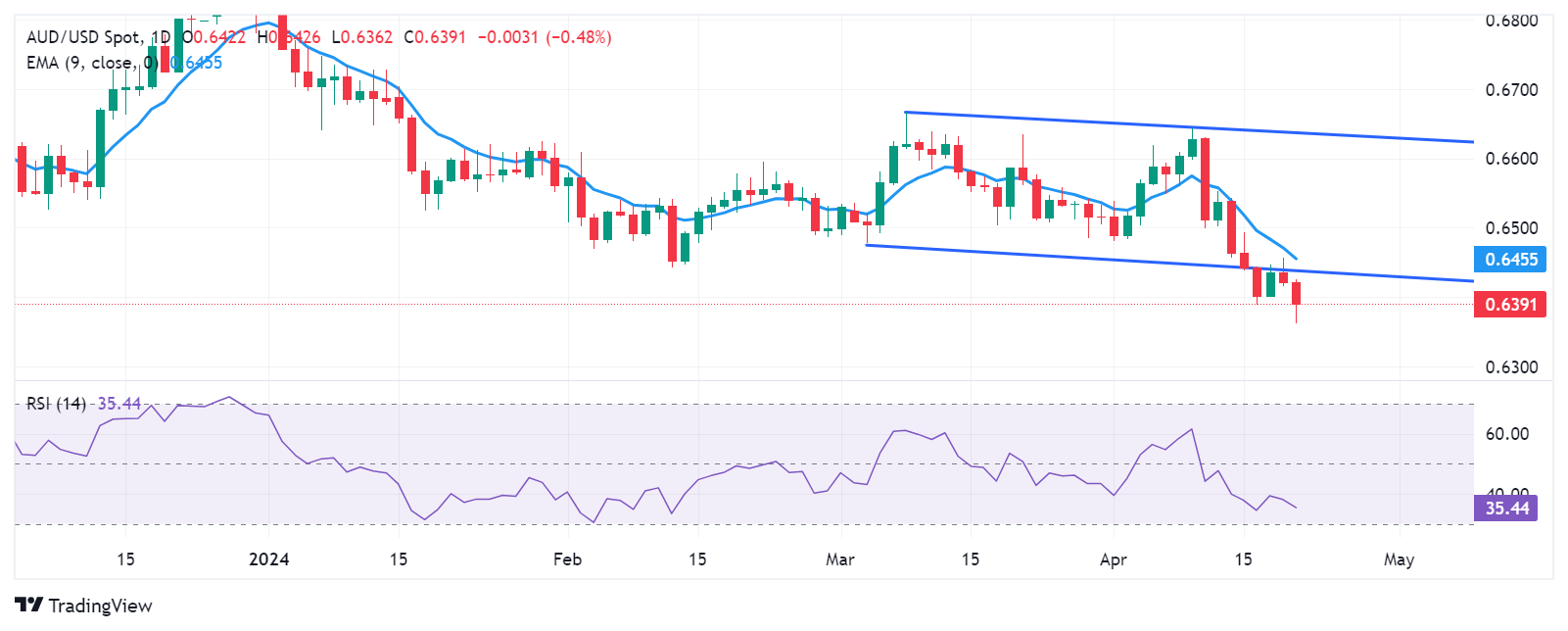Australian Dollar depreciates as riskier assets fall on escalated tensions in Middle East

- The Australian Dollar recovers intraday losses as Iranian media denies any foreign attack on its cities.
- Australia’s equity market falls to a two-month low of 7,489 on Friday.
- The US Dollar gained ground after hawkish remarks from Fed officials made on Thursday.
The Australian Dollar (AUD) remains in the negative territory after paring losses on Friday. The AUD/USD pair dropped as riskier assets faced pressure due to heightened risk aversion across financial markets. This sentiment intensified following confirmation from ABC News that Israeli missiles had struck a site in Iran, exacerbating tensions in the Middle East.
The Australian Dollar (AUD) faces challenges alongside a decline in the ASX 200 Index on Friday, nearing its two-month low of 7,489. This trend was influenced by weak cues from Wall Street overnight. Additionally, Australia’s 10-year government bond yield fell below 4.3%, retracting from over four-month highs, as investors anticipated a dovish outlook from the Reserve Bank of Australia (RBA) regarding monetary policy.
The US Dollar Index (DXY), which measures the US Dollar (USD) against six major currencies, advances amid heightened concerns over the potential escalation of the Israel-Gaza conflict in the Middle East. This has attracted investors seeking safe-haven assets. Furthermore, hawkish remarks from Federal Reserve (Fed) officials on Thursday triggered a surge in US Treasury yields and the US Dollar, subsequently exerting downward pressure on the AUD/USD pair.
Traders are expected to closely monitor upcoming speeches from Federal Reserve officials. Atlanta Fed President Raphael Bostic is set to partake in a moderated discussion regarding the US economic outlook at the University of Miami, Florida. Additionally, Chicago Fed President Austan Goolsbee is anticipated to participate in a moderated Q&A session at the Association for Business Journalists 2024 SABEW Annual Conference in Chicago.
Daily Digest Market Movers: Australian Dollar depreciates on risk aversion, dovish RBA outlook
- According to Reuters, citing Iran’s Fars News Agency, locals reported hearing explosions at the central Isfahan airport. However, the cause of these explosions remains unknown. However, Iranian media has refuted reports of a foreign attack on Iranian cities, including Isfahan.
- Atlanta Fed President Raphael Bostic highlighted that US inflation is excessively high and emphasized that the Fed still needs to make progress on addressing inflation. Meanwhile, New York Fed President John Williams stressed the Fed’s commitment to being data-dependent and expressed that he does not currently perceive an immediate need to lower interest rates.
- US Initial Jobless Claims reported a figure of 212,000 for the week ending on April 12, compared to the expected 215,000.
- US Philadelphia Fed Manufacturing Survey showed an improvement in the manufacturing sector trends with a higher reading of 15.5 for April, exceeding the expected 1.5 and 3.2 prior.
- US Existing Home Sales Change (MoM) reduced by 4.3% in March, swinging from the previous increase of 9.5%.
- Australia’s Employment Change posted a reading of -6.6K for March, against the expected 7.2K and 117.6K prior. Unemployment Rate rose to 3.8% in March, lower than the expected 3.9% but higher than the previous reading of 3.7%.
Technical Analysis: Australian Dollar falls below the psychological level of 0.6400
The Australian Dollar trades around 0.6390 on Friday. The latest break below the descending channel on the daily chart denotes a strengthening of the bearish bias. Additionally, the 14-day Relative Strength Index (RSI) suggests a bearish sentiment for the AUD/USD pair as it remains below the 50 level. Notable support is identified at the major level of 0.6350, following the psychological level of 0.6300. On the upside, immediate resistance for the AUD/USD pair is anticipated at the psychological level of 0.6400. A breakthrough above the latte could lead the pair to explore the region around the major level of 0.6450 and the nine-day Exponential Moving Average (EMA) at 0.6455.
AUD/USD: Daily Chart
Australian Dollar price this week
The table below shows the percentage change of Australian Dollar (AUD) against listed major currencies this week. Australian Dollar was the weakest against the Swiss Franc.
| USD | EUR | GBP | CAD | AUD | JPY | NZD | CHF | |
| USD | 0.04% | 0.27% | 0.08% | 1.03% | 0.74% | 1.01% | -0.53% | |
| EUR | -0.04% | 0.22% | 0.05% | 0.99% | 0.70% | 0.97% | -0.57% | |
| GBP | -0.28% | -0.23% | -0.18% | 0.79% | 0.47% | 0.74% | -0.81% | |
| CAD | -0.09% | -0.05% | 0.17% | 0.97% | 0.65% | 0.92% | -0.63% | |
| AUD | -1.07% | -1.04% | -0.82% | -0.98% | -0.32% | -0.06% | -1.61% | |
| JPY | -0.73% | -0.69% | -0.45% | -0.65% | 0.33% | 0.29% | -1.28% | |
| NZD | -1.00% | -0.97% | -0.76% | -0.92% | 0.07% | -0.27% | -1.53% | |
| CHF | 0.53% | 0.57% | 0.80% | 0.62% | 1.59% | 1.26% | 1.53% |
The heat map shows percentage changes of major currencies against each other. The base currency is picked from the left column, while the quote currency is picked from the top row. For example, if you pick the Euro from the left column and move along the horizontal line to the Japanese Yen, the percentage change displayed in the box will represent EUR (base)/JPY (quote).
Risk sentiment FAQs
In the world of financial jargon the two widely used terms “risk-on” and “risk off” refer to the level of risk that investors are willing to stomach during the period referenced. In a “risk-on” market, investors are optimistic about the future and more willing to buy risky assets. In a “risk-off” market investors start to ‘play it safe’ because they are worried about the future, and therefore buy less risky assets that are more certain of bringing a return, even if it is relatively modest.
Typically, during periods of “risk-on”, stock markets will rise, most commodities – except Gold – will also gain in value, since they benefit from a positive growth outlook. The currencies of nations that are heavy commodity exporters strengthen because of increased demand, and Cryptocurrencies rise. In a “risk-off” market, Bonds go up – especially major government Bonds – Gold shines, and safe-haven currencies such as the Japanese Yen, Swiss Franc and US Dollar all benefit.
The Australian Dollar (AUD), the Canadian Dollar (CAD), the New Zealand Dollar (NZD) and minor FX like the Ruble (RUB) and the South African Rand (ZAR), all tend to rise in markets that are “risk-on”. This is because the economies of these currencies are heavily reliant on commodity exports for growth, and commodities tend to rise in price during risk-on periods. This is because investors foresee greater demand for raw materials in the future due to heightened economic activity.
The major currencies that tend to rise during periods of “risk-off” are the US Dollar (USD), the Japanese Yen (JPY) and the Swiss Franc (CHF). The US Dollar, because it is the world’s reserve currency, and because in times of crisis investors buy US government debt, which is seen as safe because the largest economy in the world is unlikely to default. The Yen, from increased demand for Japanese government bonds, because a high proportion are held by domestic investors who are unlikely to dump them – even in a crisis. The Swiss Franc, because strict Swiss banking laws offer investors enhanced capital protection.
Information on these pages contains forward-looking statements that involve risks and uncertainties. Markets and instruments profiled on this page are for informational purposes only and should not in any way come across as a recommendation to buy or sell in these assets. You should do your own thorough research before making any investment decisions. FXStreet does not in any way guarantee that this information is free from mistakes, errors, or material misstatements. It also does not guarantee that this information is of a timely nature. Investing in Open Markets involves a great deal of risk, including the loss of all or a portion of your investment, as well as emotional distress. All risks, losses and costs associated with investing, including total loss of principal, are your responsibility. The views and opinions expressed in this article are those of the authors and do not necessarily reflect the official policy or position of FXStreet nor its advertisers. The author will not be held responsible for information that is found at the end of links posted on this page.
If not otherwise explicitly mentioned in the body of the article, at the time of writing, the author has no position in any stock mentioned in this article and no business relationship with any company mentioned. The author has not received compensation for writing this article, other than from FXStreet.
FXStreet and the author do not provide personalized recommendations. The author makes no representations as to the accuracy, completeness, or suitability of this information. FXStreet and the author will not be liable for any errors, omissions or any losses, injuries or damages arising from this information and its display or use. Errors and omissions excepted.
The author and FXStreet are not registered investment advisors and nothing in this article is intended to be investment advice.




